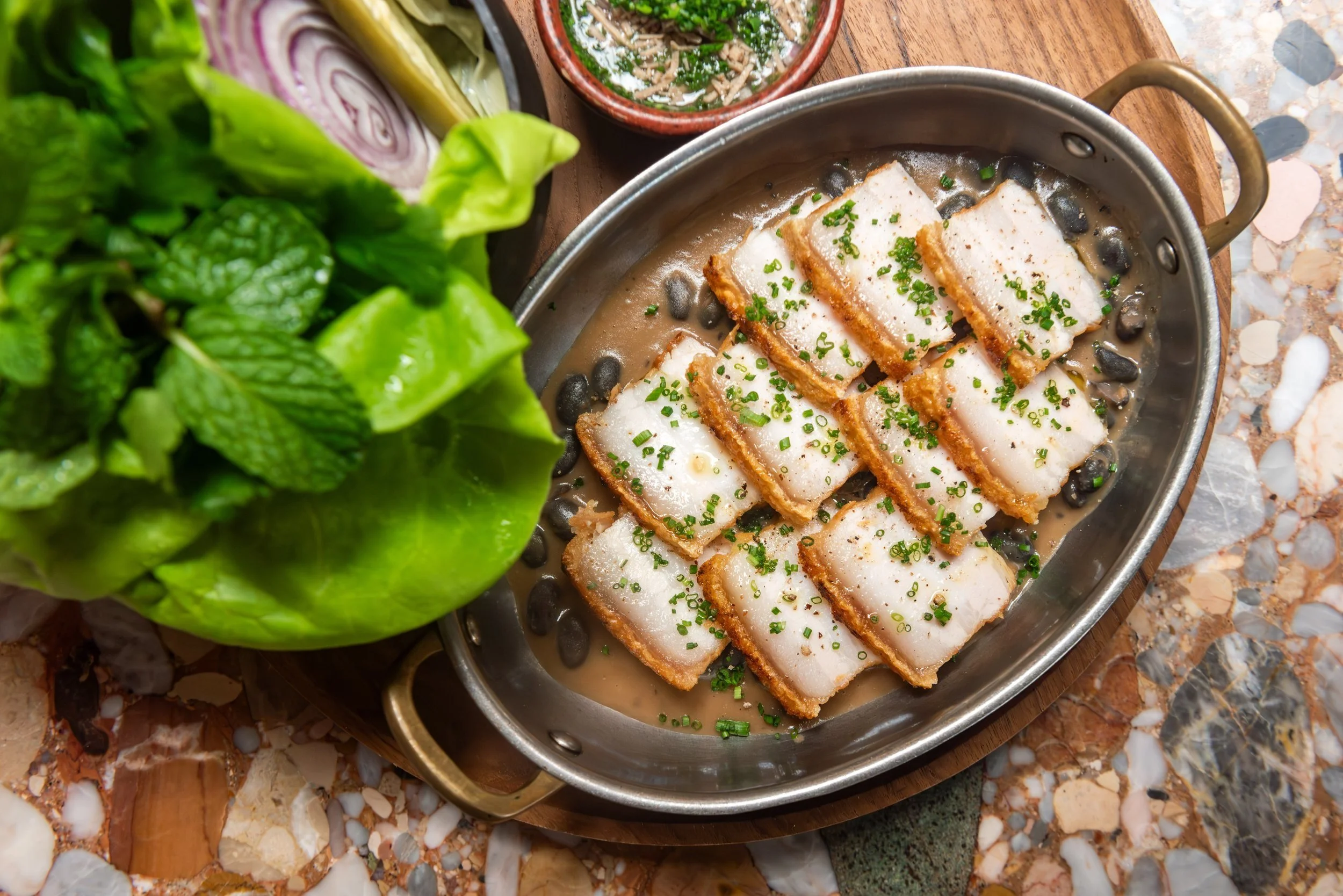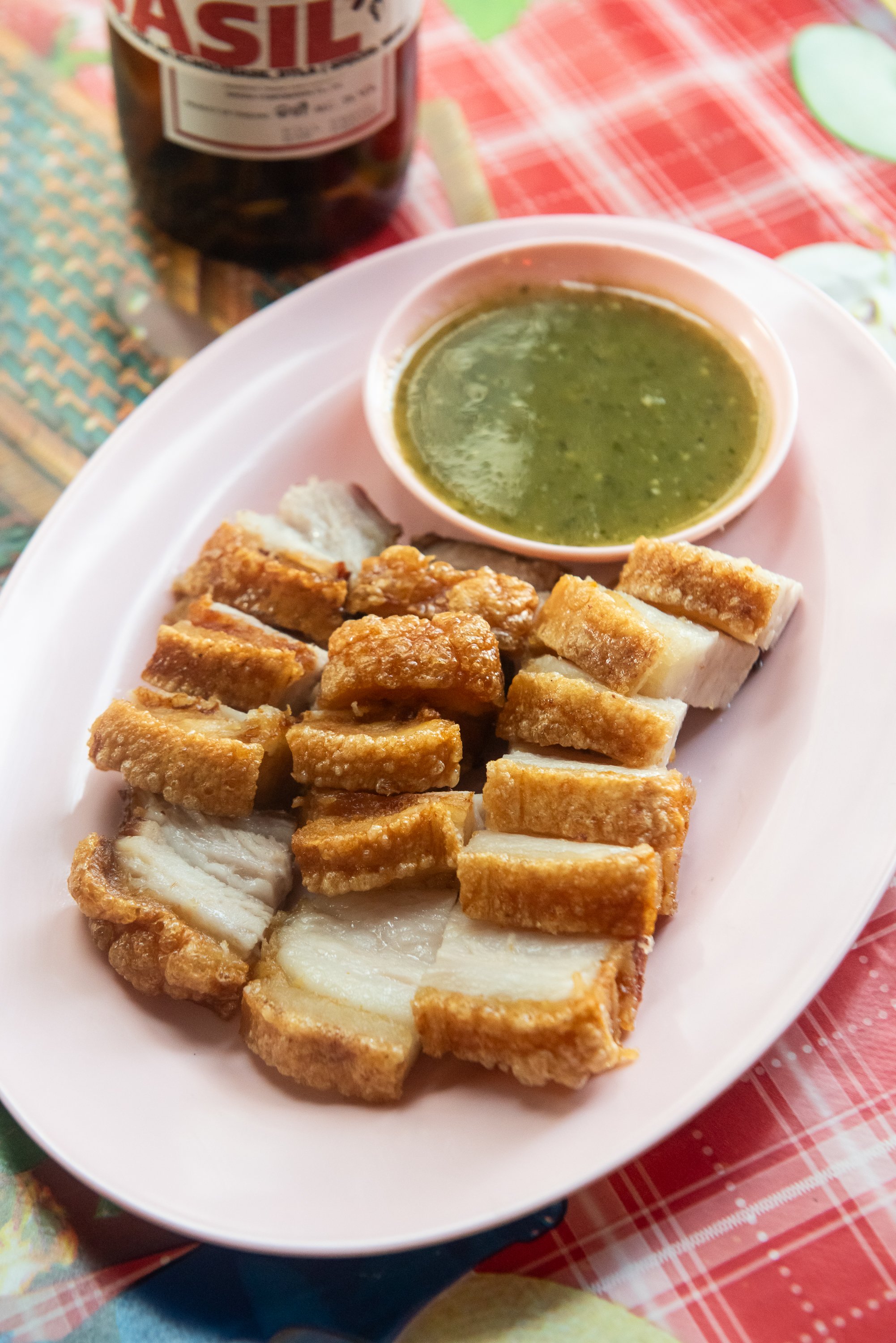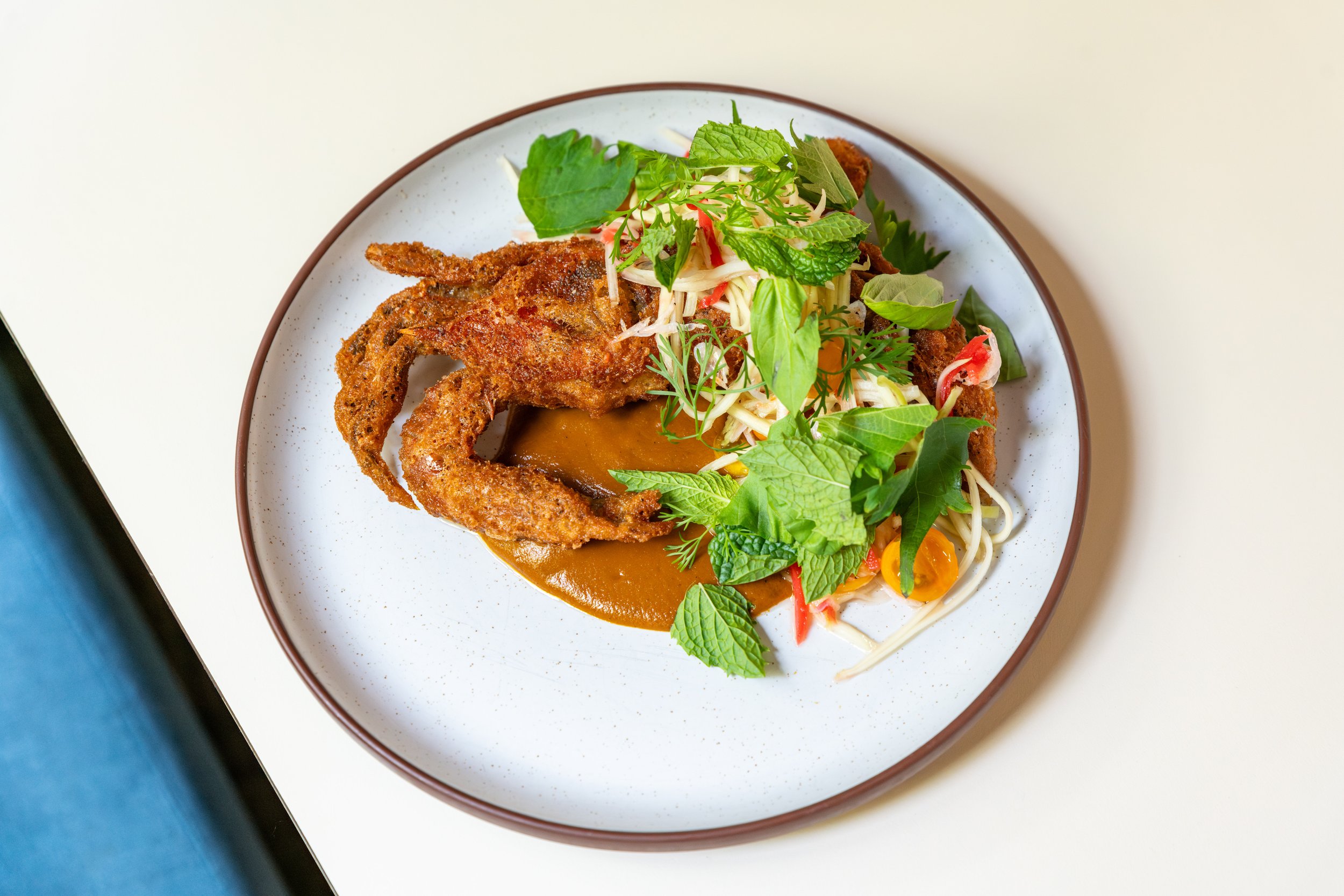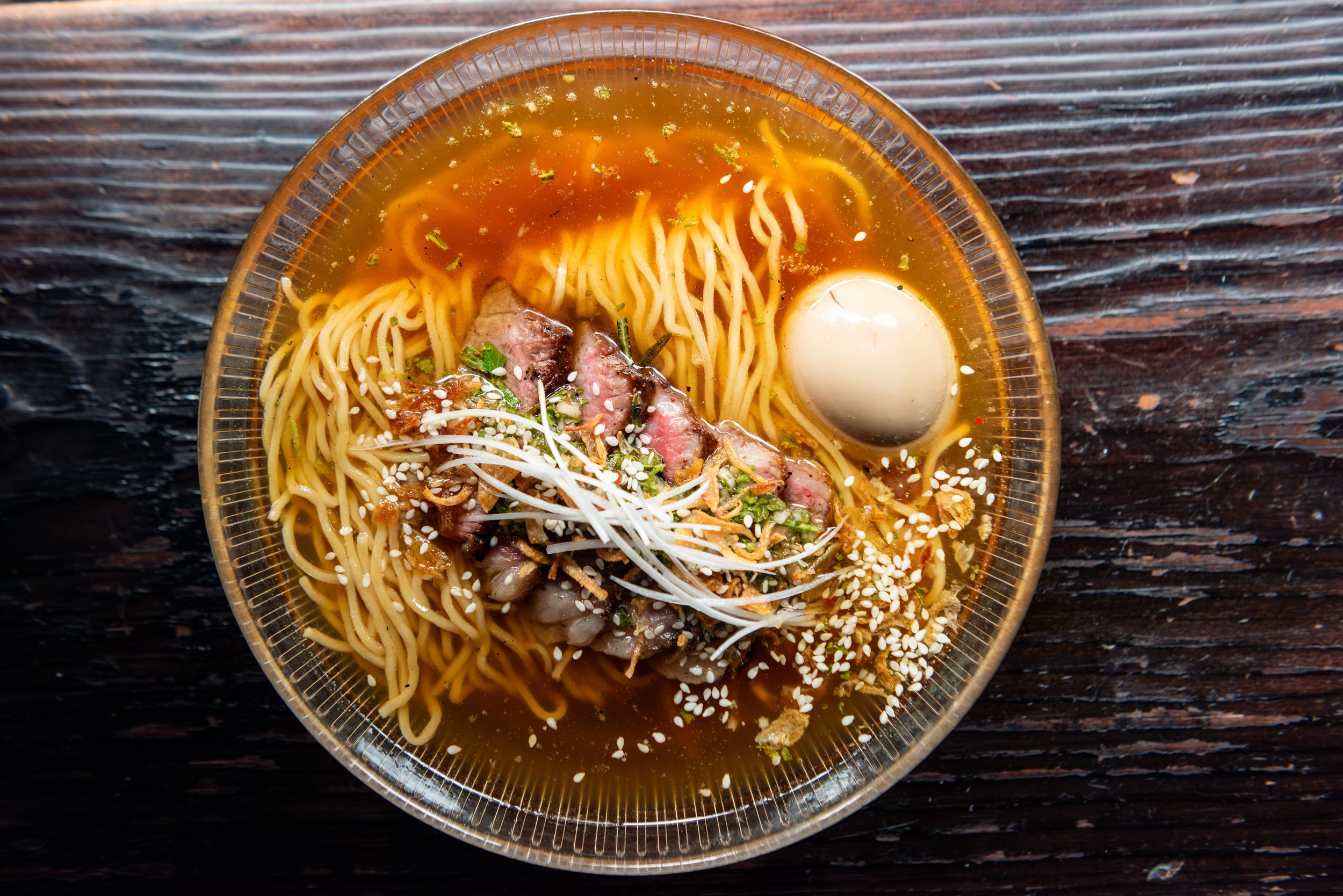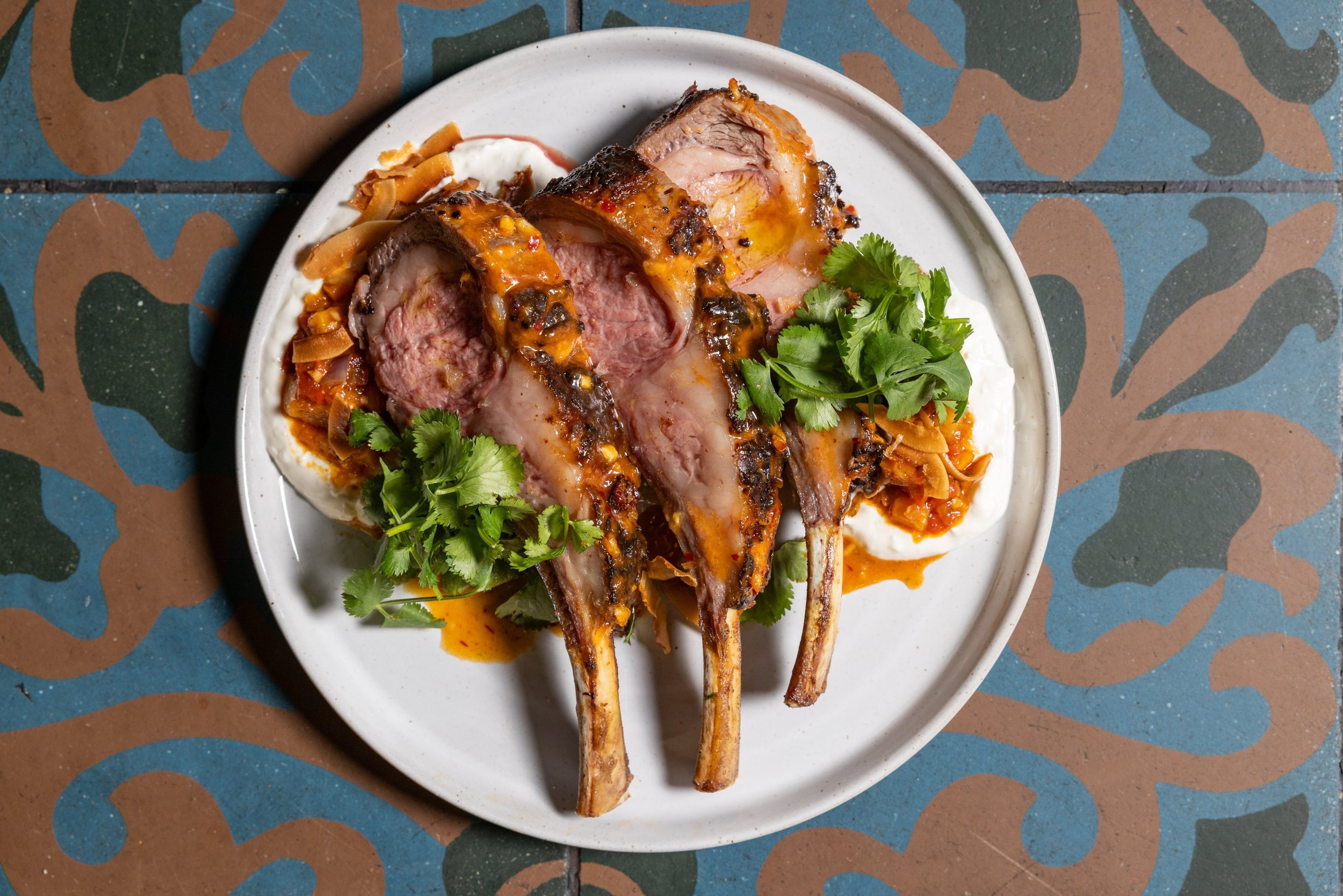How To: Crispy Pork Belly
Three chefs share their strategies for flavorful pork with a coveted crispy crust.
It’s hard to find a bite more crowd-pleasing, craveable, and comforting than crispy pork belly, but despite demand, making the most of the seemingly humble cut requires serious preparation, culinary technique, and attention to detail. Drawing inspiration from the varying—practically infinite—methods of cooking it, chefs in Los Angeles are honing in on their own formulas for success. From emphasizing the quality and flavors of the meat itself to securing a shatterable exterior skin, they are cleverly avoiding the perils and pitfalls that often lead to overly fatty, tough, and generally unpleasant pork belly. Here, we take a peek behind the pass and follow along as these chefs explain their pork belly processes.
Si! Mon’s Crispy Pork Belly, Butter Lettuce, Cranberry Bean Purée, Black Beans, Coconut Vinegar, Herbs, Pickled Serrano
THE CURE
At Si! Mon, Chef Christian Truong cures his pork belly for over 48 hours. But before he air-dries the pork in the walk-in, the flesh side gets a generous coating of five spice, sugar, and salt while the skin side is prepped with the help of a needle-lined meat tenderizer. You need to “prick the skin,” says Truong, but, “you have to be careful not to pierce it into the flesh, because then the meat juices will break through and make the skin wet, which prevents it from getting crispy.”
Like Truong, Chef Cynthia Hetlinger of RYLA in Manhattan Beach also tenderizes her pork belly by poking holes all over the skin to help the pork dry out. But first, Hetlinger steams the belly in a combination oven, because “it softens the top layer of the skin.” Her pork belly is then salted and covered with a vinegar-baking soda solution before it is left uncovered in the walk-in for around 48 hours. Hetlinger is careful when it comes to the length of the cure. “If you don't dry it out long enough,” says Hetlinger, “it becomes tacky, not crispy.” She dusts the flesh with her own spin on Chinese five spice, a little brown sugar, and a delicate layer of Shaoxing wine. She wraps the flesh in foil and lets the seasonings marinate the pork as the skin continues to dry.
Allowing the pork ample time to dry out is key to achieving a crispy exterior. Sans salt, sans spice, sans anything, Chef Deau Arpapornnopparat of Holy Basil lets his pork belly dry without any manipulation. It is “zero seasoning,” says Arpapornnopparat, "but we are taking time to define the texture and the fat” of the pork. After an uninterrupted 48 hours in the refrigerator, the pork is finally seasoned with salt before it is baked.
TIME TO BAKE
After curing, Truong removes the belly from the walk-in, cuts his pork into two manageable pieces, wraps the flesh in aluminum foil, and brushes the skin with distilled white vinegar which “helps eliminate the funky pork smell of the skin.” Covered completely in rock salt in order to draw out more moisture as it cooks, the pork is roasted in the oven at 350°F for about an hour. He then brushes off the salt, rewraps the flesh, and cranks the heat to 500°F to crisp the skin even further. For around 20 minutes, the pork is cooked until the skin is crispy and puffy. It’s “normal that the skin will burn,” says Truong, “it’s a typical Chinese technique…you let it burn and get crispy and then scrape the burnt parts off.”
“I really wanted to master the crispy skin,” says Hetlinger. “Something I love is Cantonese-style barbecue. It's just as amped-up and technique-driven [as American barbecue].” Drawing on that Cantonese influence, Hetlinger’s pork is roasted at around 350°F for roughly 40 minutes and then on high until the skin fries. “But I play around with it,” she says, watching diligently and adjusting the temperature between 375°F and 450°F, aiming for a chicharrón-like texture.
Arpapornnopparat bakes his pork belly at a lower 250°F. For about two hours, the pork is slowly cooked until “the skin gets leathery,” says Arpapornnopparat. The longer cooking time keeps the pork juicy and “renders the smelly or gamey part of pork out.” The belly is removed from the oven to rest before it’s fried.
holy basil’s Moo Krob: Crispy Pork Belly, Tomatillo Holy Sauce
RYLA”s Bo Ssam: Crispy Pork Belly, Lettuces, Taiwanese Cabbage Kimchi, Black Bean Hoisin, Fresno Chile Vinegar
WHY FRY?
For pick-up, Truong drops the crispy pork in the fryer. Not simply for the sake of frying, but because that quick, final cook warms up the belly to the exact temperature Truong is looking for and reinforces the crispy coating.
At Holy Basil, the fryer is essential to achieving the pork skin’s crispy texture. At 400°F, hot oil bathes the belly until the skin takes on a crunchy and crackly texture and becomes golden brown. It is “one of our most popular dishes,” says Arpapornnopparat, and the preparation is “also really good for production.” With two locations, one in Downtown Los Angeles and the other in Atwater Village, finding a way to maintain the crispiness and juiciness of the pork at Holy Basil took time, but now, “anyone can do it,” making it an easy dish to execute successfully during service.
SAUCE IS SERVED
Once the pork is finished, each chef prioritizes finding balance with acid before presenting their dishes to the guest. Sauces, in particular, transform these treasured morsels of pork into complex, satisfying bites. At Si! Mon, the pork is served over beef fat-cooked cranberry beans, but a fermented coconut vinegar—alongside fresh herbs and various lettuces—helps to cut through the richness of the dish (recipe). Even though the vinegar, aged for eight months, “was [originally] supposed to be a mignonette for oysters,” says Truong, “it tasted really good” with the pork. Through the dish, Truong represents his own Vietnamese culture, as well as Executive Chef José Olmedo Carles Rojas’ Central American upbringing. “We both like to eat things with a lot of condiments,” he says, “and with our hands.” Guests are encouraged to wrap the pork and beans in lettuce and top their bites with a slice of serrano, herbs, and a liberal spoonful of the coconut vinegar.
At RYLA, the crispy pork belly is served like Korean bo ssam. Seasonal greens, lettuces, and chicories, like pink radicchio and salanova, accompany the salty, fatty pork. Paying homage to her Taiwanese roots, Hetlinger serves the belly with Taiwanese cabbage kimchi, a fermented black bean sauce, and a Hakka sauce. “Because pork is so fatty,” says Hetlinger, “most of the things I thought about were 'How do you cut through it so you can eat more?'”
Keeping it simple, clean, and craveable as ever, Arpapornnopparat serves his deep fried pork belly with a clever Thai-inspired tomatillo sauce (recipe). Based on a traditional Thai seafood condiment, his Holy Sauce is a blend of roasted tomatillos, palm sugar, cilantro, garlic, Thai chile, and fish sauce.

